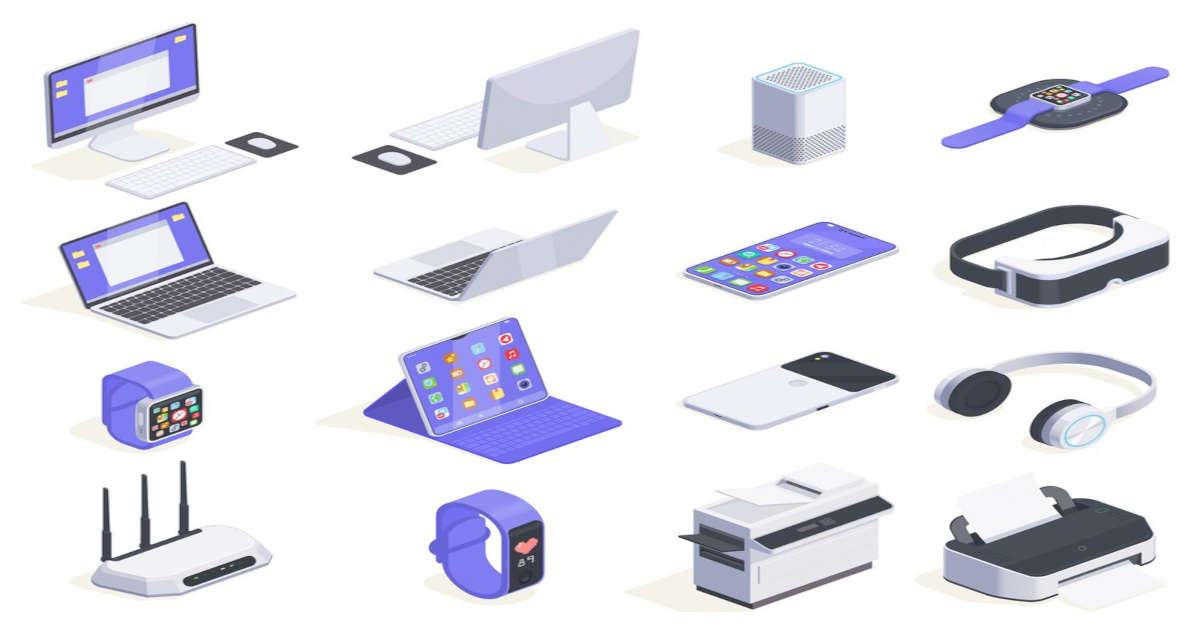Computing Devices and Peripherals
Identifying Hardware Components and Peripherals
What is a computer component?
- A physical part needed for computer functioning, also called “hardware”.
- Each component performs a specific task.
- Components can be internal or external.
- External components connect via ports and connectors.
- Without a given component, such as a CPU, a computer system cannot function as desired.
Common internal components
A part inside a computing device:
- RAM
- Hard Drive
- CPU
Peripherals
- Connect to the computer to transfer data.
- External devices easily removed and connected to a computer.
- Connections vary
- Examples: Mouse, Printer, and a Keyboard etc.
Categories of peripherals
- Input – send commands to the computer
- Output – receive commands from the computer
- Storage – save files indefinitely
Connectors for Components
- A connector is the unique end of a plug, jack, or the edge of a card that connects to a port.
- For example, all desktop computer expansion cards have an internal connector that allows them to connect to a slot on the motherboard.
- A Universal Serial Bus (USB) connector at the end of a cable is an example of an external connector.
Ports
- A connector plugs into an opening on a computer called a port.
- A port is the jack or receptacle for a peripheral device to plug into.
- Ports are standardized for each purpose.
- Common ports include USB ports and HDMI ports.
Input and Pointing Devices
Input Devices
- Keyboards
- Mouse
- Camera
- Joystick
- Trackball
Pointing Devices
- The stylus (Pen)
- Input tool
- Moves the cursor and sends commands
- Generally used on tablets
- Uses capacitive technology
- Detects heat and pressure
Hard Drives
Hard drives:
- are a repository for images, video, audio, and text.
- RAM
- ROM
- HDD/SSD/NVMe
Hard drive performance
Measurement benchmarks
- Spin speed: how fast the platter spins.
- Access time: how fast the data is retrieved.
- Transfer/media rate: how fast the data is written to the drive.
Connecting an internal hard drive
- Back up data
- transfer the enclosure
- Secure with screws
- prevent movement
- attach to motherboard via SATA/PATA cables
- plug into power supply
- finally, it can be configured in the disk management utility of windows
Optical Drives and External Storage
Optical drives
Reading and writing data
- Laser pressing or “burning”
- Burning pits on lands
Reflective disk surface
Storage disks
- Single-sided
- Double-side
Types of optical drive
Several types
- CD-ROM
- CD-RW
- DVD-ROM
- DVD-RW
- Blu-ray
Solid state drives
Solid state drive → (SSD)
- Integrated circuit assemblies store data
- Flash memory
- Permanent, secondary storage
- AKA “solid state drive” or “solid state disk”
- No moving parts
- Unlike hard disk drives and floppy drives
External hard drive
- File backup and transfer
- Capacity: 250 GB to 20 TB
- Several file types
- USB or eSATA connection
- eSATA – signal, not power
Expansion devices
- Additional file storage
- Usually, USB
- Frees hard drive space
- Automatically recognized
- Known as a “Thumb drive”
- Holds up to 2 TB of data
Flash Drives
- Combines a USB interface and Flash memory
- Highly portable
- Weighs less than an ounce
- Storage has risen as prices have dropped
- Available capacity up to 2 TB
Memory card
- Uses Flash memory to store data
- Found in portable devices such as portable media players and smartphones
- Contained inside a device
- Unlike USB drives
- Available in both Secure Digital (SD) and Micro Secure Digital (MSD) formats
Display Devices
Defining display devices:
- Hardware component for the output of information in visual form
- Tactile monitors present information in a fingertip-readable format
- Often seen as television sets and computer monitors
Cathode ray tube (CRT) monitors
- Create an image by directing electrons beams over phosphor dots
- Used in monitors throughout the mid to late 1990s
- By 1990, they boasted 800 × 600 pixel resolution
Flat-screen monitors
- Also known as liquid crystal display (LCD)/ Think film transistor (TFT)
- Digital signal drives color value of each picture element (Pixel)
- Replaced CRT monitors
Touchscreens
- Use a touch panel on an electronic display
- Capacitive technology measures heat and pressure
- Often found on smartphones, laptops, and tablets
Projectors
- Take images from a computer and display them
- the surface projected onto is large, flat, and lightly colored
- Projected images can be still or animated
Printers and Scanners
Output devices
“Hardware that shows data in readable form.”
That data can take many forms:
- Scanner and speech synthesizer
- Unnecessary (though highly useful) for computer function
Printers
- Laser/LED
- Inkjet
- Thermal
Shared printers
- IP-based
- Web-based
Scanners
- Converts images from analog to digital
- Flatbed (stand alone) or multifunction device
Faxes and multifunction devices
- Facsimile (fax) machines send documents using landlines
- Multifunction devices often include fax capabilities
Audio Visual Devices
Defining audio devices
- Digital data is converted into an audible format
- Components are used to reproduce, record, or process sound
- Examples include microphones, CD players amplifiers, mixing consoles, effects units, and speakers
Defining visual devices
- Present images electronically on-screen
- Typically, greater than 4” diagonally
- Examples include smartphones, monitors, and laptop computers
This post is licensed under CC BY 4.0 by the author.
